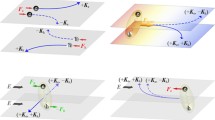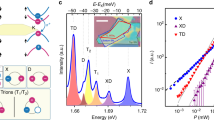Summary
This paper considers the effects on the symmetries and binding energies of biexcitons of 1) the short-range interaction (Coulomb and exchange), 2) a multi-valley conduction band and 3) the mass anisotropy of the valleys. It demonstrates that the ground state of the biexciton in a multi-valley semiconductor should be a spin triplet with an antisymmetric valley function and that poly-excitons X x ,x>2, should be stable in a material like Si.
Riassunto
Questo articolo prende in considerazione gli effetti sulle simmetrie e le energie di legame dei bieccitoni dovuti a 1) interazioni a corto raggio (di Coulomb e di scambio), 2) una banda di conduzione a più minimi e 3) anisotropia della massa dei minimi. L’articolo dimostra che lo stato fondamentale del bieccitone in semiconduttori a più minimi dovrebbe essere un tripletto di spin con una funzione antisimmetrica, e che i polieccitoniX n ,n>2, dovrebbero essere stabili in un materiale come il silicio.
Резюме
В этой статье рассматривается влияние на симметрии и энергии связи биэкситонов: 1) короткодействующего взаимодействия (кулоновское и обменное), 2) многодолинной зоны проводимости и 3) анизотропии массы для долин. Показывается, что основное состояние биэкситона в многодолинном полупроводнике должно быть триплетным по спину и иметь антисимметричную долинную функцию. Отмечается, что полиэкситоны X n ,n>2, должны быть устойчивыми в материалах типа кремния.
Similar content being viewed by others
Footnotes
O. Akimoto andE. Hanamura:Journ. Phys. Soc. Japan,33, 1537 (1972);W.-T. Huang:Phys. Stat. Sol.,60 (b), 309 (1973);W. F. Brinkman, T. M. Rice andB. Bell:Phys. Rev. B,8, 1570 (1973). See also references therein to previous work.
This is also called the «interband» interaction. SeeE. Hanamura:Journ. Phys. Soc. Japan,39, 1506 (1975). The «Coulomb» part is recognized in this reference.
The exchange interaction of excitons is discussed in the following two useful papers.G. E. Pikus andG. L. Bir:Sov. Phys. JETP,33, 108 (1971)—here in eq. (47) the sign ofΛ 1 should be changed—andM. Suffczynski, L. Swierkowski andW. Wardzynski:J. Phys. C,8, L52 (1975).
The dependence of ε onr 12 is neglected in this paper. SeeH. Haken: inPolarons and Excitons, edited byC. G. Kuper andG. D. Whitfield (Edinburg, 1963), p. 295.
E. J. Elliott: inPolarons and Excitons, edited byC. G. Kuper andG. D. Whitfield (Edinburgh, 1963), p. 269, especially eq. (6.7).
E. U. Condon andG. H. Shortley:The Theory of Atomic Spectra (Cambridge, 1935). A hole is completely analogous to a nearly filled atomicp-shell (p 5). Hence, the exciton levels are split as shown in fig. 313, p. 304 of this reference.
The exchange contribution to biexcitons has been described byJ. J. Forney, A. Quattropani andF. Bassani:Nuovo Cimento,22 B, 153 (1974). I am indebted toDr. Quattropani for useful discussions of the electron-hole exchange interaction.
These «para-exciton» states correspond to the singlet nuclear spin state of parahydrogen. The corresponding «ortho-exciton» states have a two-hole «spin» of 1 or 3.
Such a state can also occur in the bound exciton (D0, X).
Under certain conditions the (hole)J=3 «ortho-exciton» state (ref. (8)) These «para-exciton» states correspond to the singlet nuclear spin state of parahydrogen. The corresponding «ortho-exciton» states have a two-hole «spin» of 1 or 3. coupled to the electron spin triplet could form a ground state havingJ t=4.
SeeA. Quattropani, J. J. Forney andF. Bassani:Phys. Stat. Sol.,70 (b), 497 (1975).
This conclusion differs from that of ref. (11)..
J. S.-Y. Wang andC. Kittel:Phys. Lett.,42 A, 189 (1972).
This effect was considered (and observed) for D− donor ions byS. Narita andM. Taniguchi:Phys. Rev. Lett.,36, 913 (1976);Proceedings of the XIII International Conference on the Physics of Semiconductors, Rome, 1976 (to be published).
G. L. Bir andG. E. Pikus:JETP. Lett.,18, 146 (1973).
V. M. Asnin, G. L. Bir, Yu. N. Lomasov, G. E. Pikus andA. A. Rogachev:Proceedings of the XII International Conference on the Physics of Semiconductors, Stuttgart, 1974 (Stuttgart, 1974), p. 96.
SeeT. Baba andT. Masumi: this issue p. 609,I. Pelant, A. Mysyrowicz andC. Benoît à la guillaume: this issue, p. 655.
See, for example,J. L. Staehli: this issue, p. 634.
Author information
Authors and Affiliations
Additional information
Traduzione a cura della Redazione.
Ререведено редакцией.
Rights and permissions
About this article
Cite this article
Morgan, T.N. Properties of biexcitons in multi-valley semiconductors. Nuov Cim B 39, 602–608 (1977). https://doi.org/10.1007/BF02725798
Received:
Published:
Issue Date:
DOI: https://doi.org/10.1007/BF02725798




